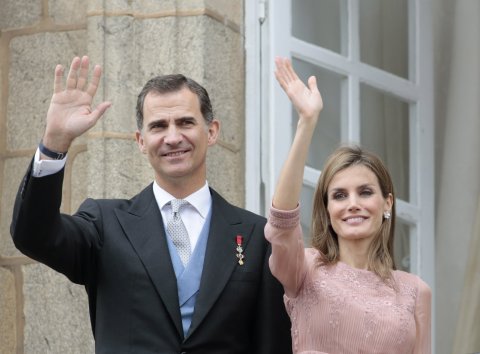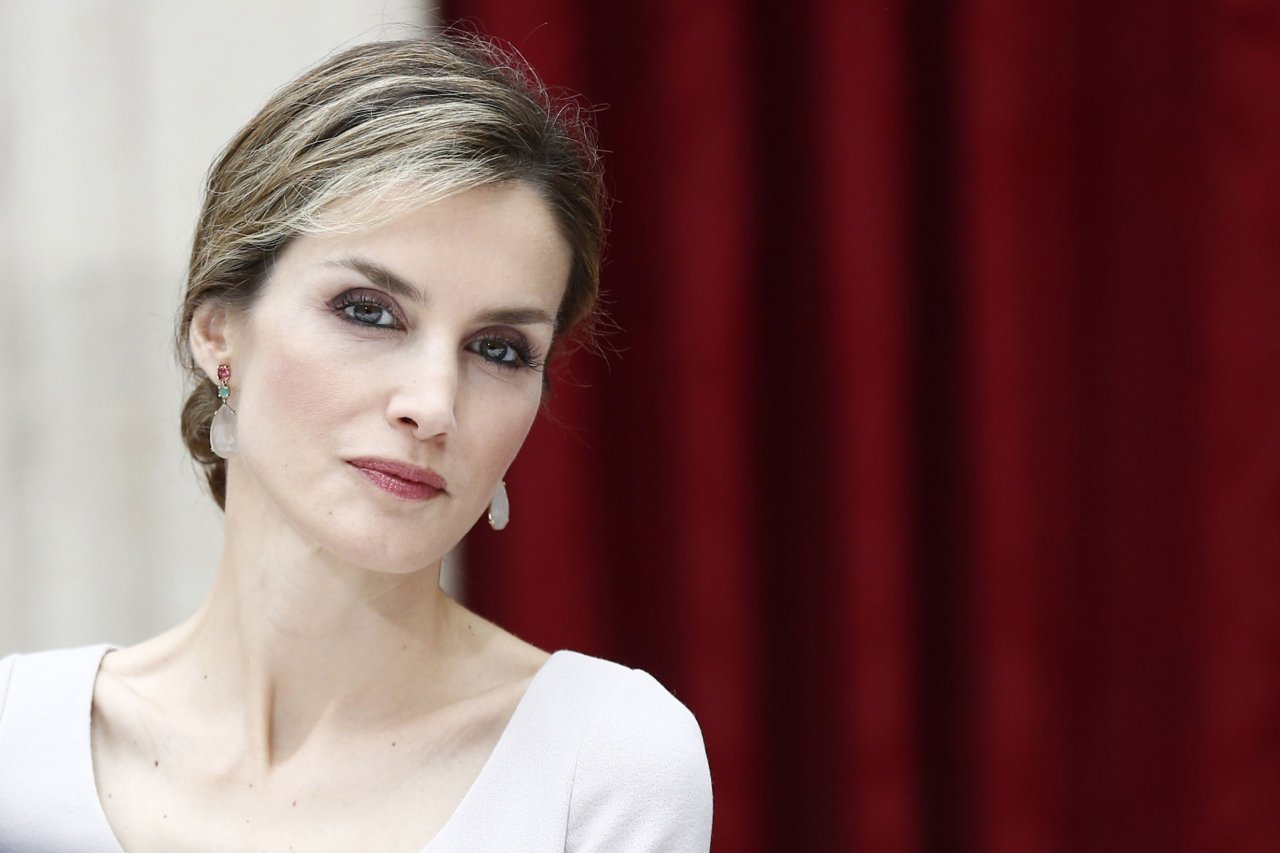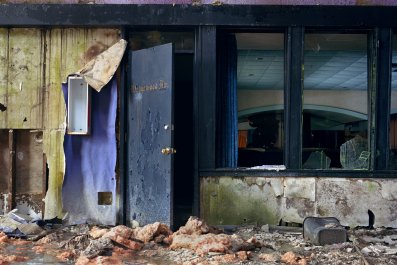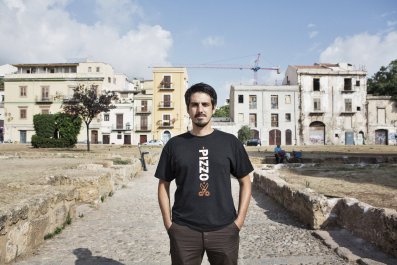Queen Letizia of Spain enters the darkened music school auditorium to a gentle murmur of applause from her public. There is no official announcement, no standing ovation and no anthem is played. She just slips down the aisle with her head slightly bowed looking polished to a gleam in a silver silk blouse, grey pencil skirt and snake-skin stilettos, her dark blonde hair loose around her narrow shoulders. She is impossibly thin – so thin it's impossible not to remark on it, so thin she makes the Duchess of Cambridge look like Marilyn Monroe – and as perfectly made-up and daintily-boned as a mechanical doll constructed for the purposes of being The Most Glamorous Royal in Europe, the unofficial title she has held, alongside her official one, ever since marrying Prince Felipe of Asturias (now the reigning king) 10 years ago.
Letizia, as she is called in these parts, is here at the Prince of Asturias International Music School in Oviedo, Spain representing her husband's cause. The Prince's foundation is a cultural charity that supports the arts in the region, most notably the school she is visiting today. The queen sits in the front row and watches an address and performance by the Lebanese violin virtuoso Ara Malikian.
Afterwards, in a classroom down the hall, she meets and chats with the students in the school's international summer programme. A bank of photographers jostle for a better angle and are shoved back by security, keen to give the queen some space. Letizia is reserved in the bustle, conversing sedately with the students, asking questions and nodding her head. But as soon as security herds snappers out of the room she visibly relaxes. Her tiny shoulders lower and she laughs, sharing jokes in perfect English with Malikian who has come to join the crowd. She poses for school pictures and even a for couple of selfies with the young music students, hugging them and laughing freely. Spotting one lone reporter standing on the sidelines she does something royals almost never do. She comes over and introduces herself with a bright-eyed gaze and a bone-crushing handshake.
"You must come to Madrid to meet my husband," she says warmly. "I think you would like him. Promise me you will come?" I say yes of course and vow to follow up. Her press officer, who has witnessed the exchange, later ushers me out. When I mention the queen's invitation he shrugs and says: "You can try." Later he doesn't bother to return my emails.
For the unpopular and scandal-plagued House of Bourbon, much depends upon Letizia, Queen of Spain. The first Spanish-born queen in more than a century and a commoner to boot, she might seem at first glance, a perfect candidate for job. "A breath of fresh air," as so many royal commentators said of the common-born Duchess of Cambridge. But Letizia is a far more complicated creature than her distant royal-cousin-by-marriage (King Felipe's Greek aristocrat mother is related to Prince William's grandfather, the Duke of Edinburgh). She is older and wiser in the ways of both love and work. Beneath all the on-trend Zara frocks, perfect lip gloss and suspiciously sculpted features (the question of whether or not she has had a nose job is an enduring obsession of the Spanish tabloids) she is a woman of both substance and experience. The question is, will this actually help her to be a modern royal – a role arguably better suited to an inexperienced ingénue (like Kate) or Stepford-style robot.

HOUSE OF SCANDAL
At the end of July, King Felipe VI, Spain's newly-crowned monarch, announced he was stripping all members of his family of their royal responsibilities save his immediate family. What this means is that only his father and mother, his wife and their two daughters, the Princesses Leonor and Sofia, will be officially considered members of the royal family of Spain. Felipe's sisters, Cristina and Elena de Bourbon, the Duchesses of Palma de Mallorca and Lugo respectively will no longer be officially part of the royal family, although they will retain the title 'infanta'.
He also introduced strict rules forbidding members of the royal family from working for private sector companies and subjecting the accounts of the royal household to an external audit. The rules are just the latest move in a broader public relations campaign to lift the monarchy in the public's esteem.
It is going to be an uphill battle. Cristina is currently facing trial for corruption in the Balearic island of Mallorca where the family has a summer home. Her husband, the former handball player Inaki Urdangarin, is accused of using royal influence to make real estate deals and he and his wife are charged with both tax fraud and money-laundering. The trial is ongoing. In addition to this, Felipe's father, the former King Juan Carlos – a man who skillfully helped deliver the country into democracy after Franco's fascist dictatorship – has had his reputation tarnished by decades of rumoured infidelities and leaked 2012 photos of a decadent elephant hunting trip while the country's economy languished.
The surprise abdication and quiet succession earlier this year were undoubtedly an attempt to refresh the country's image of a spendthrift and corrupt monarchy in peril. Despite this, a recent poll by Metroscopia found that two thirds of Spaniards would still like to see a referendum on the future of the monarchy. While other polls suggest that though there is still broad support for the institution (rather than a republic), the House of Bourbon is undergoing an image makeover and their unusual queen is at the centre of the strategy.
AN UPHILL BATTLE
The small northern city of Oviedo (population 225,000) is the capital of the principality of Asturias, a region dignified by its former royal namesake, Prince Felipe VI of Asturias. But what is less well-known about this rainy little capital, with its quiet cobbled squares, peaceful public gardens and respectable suburbs, is that its also the hometown and birthplace of a beautiful, driven and somewhat tightly-wound girl from a staunchly republican family who would eventually become his Felipe's bride and mother to his heirs. But despite her fairytale ascendancy, Letizia Ortiz Rocasolano is the most unlikely royal in Europe, let alone queen. A divorced former television journalist, she has been both a war reporter and a news anchor. By the age of 30 she had lived and travelled around the world, been embedded with the military in Iraq, reported from Ground Zero during 9/11, been depicted half-naked on the cover of a pop album. Her private life as a young adult was equally eventful. She had had an affair with a Latin American rock singer in Mexico City, married and divorced her high school teacher and had a live-in relationship with a sports reporter in Madrid, all before she met her prince.
If Kate Middleton is a blank, history-free canvas on which the royal family can sit back and let the British public project their hopes and dreams, then Queen Letizia is the opposite. She is a fully-formed woman with a colourful past – and although we will likely never hear them – strong opinions. Her decision to wear the crown was not one born of innocent first love but knowing adult calculation.

This is not to suggest she doesn't love her husband – by all accounts their marriage is a very close and happy one – but that unlike most royal princesses-turned-queens she has experienced private life in all its myriad pleasures, frustrations and heartbreaks. In entering the public sphere she is a woman who knows exactly what she is gaining (palaces, wealth, access to some of the world's most interesting and powerful people) and what she is losing as well (her privacy, career and the ability to speak freely in public).
Growing up in Oviedo, Letizia was a studious, high-spirited girl. Her former primary school head master, Federico Perez Huerta, describes her as "very intelligent and hardworking – but with a sharp edge". He shows me the homeroom at the Instituto Nacional De Ensenaza Media Alphonso II where Letizia spent most of her early education. It's in a large, nondescript 1930s building, typical of Spanish state schools, across from Oviedo's calm San Francisco Gardens. Asked if Letizia ever wound up in the headmaster's office Huerta shakes his head firmly. "No, not once. She was a very good girl."
REPUBLICAN ROYALTY
Letizia's upbringing, while regular from a socio-economic standpoint, was extraordinary in other ways. Her father, Jesus José Ortiz Alvarez worked in radio and her mother, María de la Paloma Rocasolano was a nurse and active trade unionist. Her grandmother, María del Carmen Alvarez del Valle (known as Menchu), was a local celebrity, famous for her weekly chat show on Radio Oviedo.
The family were known for their strident anti-monarchist politics. According to some reports, the family would regularly jeer at the royals on the television news and wore their republican politics on their sleeves. Indeed, the ascension of Letizia doesn't seem to have changed things. The day after it was announced her husband would become king, Letizia's aunt, Henar Ortiz Alvarez, caused controversy by tweeting her support for a referendum on the future of the Spanish monarchy: "It's time for people to speak," she wrote in a missive that was re-tweeted thousands of times over. "Sign and re-tweet."
In her early teens, Letizia's father moved to Madrid for work and she and her sister Telma soon followed, attending the Ramiro de Maeztu Institute, where she thrived. Her mother stayed behind in Oviedo with the youngest Ortiz daughter Erika.
As a teen, Letizia was a meticulous student and a young woman who valued self-control above all else. It was then that she began carefully managing her weight – her bird-like appearance has long been the cause of speculation about her "control issues" among the Spanish tabloid media – and also when she met her future husband Alonso Guerrero Pérez, her high school literature teacher. Alonso, who was 10 years older than Letizia, became very close to her family and, though the couple broke up after Letizia completed her studies in journalism at Complutense University in Madrid, they eventually reunited and agreed to marry when Letizia was 25.
That Letizia's quiet civil ceremony occurred shortly after the news of her own parents' divorce is no coincidence, friends have told the press. And if the decision to marry was taken in haste perhaps that's the reason it didn't last. Within a year the couple had separated.
MEETING HER PRINCE
In her late 20s and early 30s, Letizia lived in Madrid working as a TV news reporter, first for Bloomberg and later CNN. During this time she began dating and eventually moved in with the sports broadcaster David Tejera. In her late 20s and early 30s, Letizia excelled as a journalist. She travelled to the US frequently during those years, covering both the US presidential elections from Washington and the carnage of 9/11. Later, she would be embedded with the military to cover the war in Iraq. For her coverage, she won the Madrid Press Association's Larra Award for most accomplished journalist under the age of 30.
Letizia was moving in high-flying Madrid media circles. She'd even met Prince Felipe at a dinner party in Madrid hosted by a mutual friend. But it wasn't until the autumn of 2002, when she travelled back to her home province of Asturias to cover the sinking of the oil ship Prestige that her romance with the prince began. Felipe was there, offering his help and support to the communities badly affected by the spill and, once the cameras were turned off, he and Letizia got chatting.
The spark was immediate. The couple began secretly dating, occasionally travelling to Oviedo to visit Letizia's grandmother so they could spend time together out of the media glare.
Within six months, Letizia quit her job as a news anchor and the couple's engagement was announced to a stunned Spanish public.
It was a shock – though not an entirely a bad one – that King Juan Carlos, a man whose own marriage had been arranged by his parents, would consent to his son marrying a divorcee. A key factor in securing his permission was the fact that Letizia had been married the first time only in a civil ceremony. Had she wed in a church, the Catholic church would refuse to perform the ceremony, making the union an impossibility.
At the official announcement, Letizia made waves at the press conference by telling her interupting husband: "Let me finish."

Since then, the rumours of her feistiness have abounded. She was rumoured to have attempted to suss out a royal mole in her midst during her first pregnancy by declaring to the palace staff that she was having a boy and naming him Pelayo. And her rumoured impatience with royal duties is legendary. She did few solo events while her daughters were small and, until recently, did not take on much charitable work of her own.
Much was made of the fact that she cut short the annual summer holiday to Mallorca last year, presumably because she tired of always going on holiday in the same stuffy castle just up the road from the sleazy Magaluf resort.
THE OUTSIDER
For all her perceived haughtiness, Letizia has been a well-behaved, if somewhat ambivalent royal.
"She's certainly the most glamorous of all the European Queens," says the royalist Jerramy Fine, author of Bright Young Things: Your Guide to the Next Generation of Bluebloods.
"Comparatively speaking across the continent, the House of Bourbon has the most scandal and the least popularity so it will be challenging for her. Though in some ways it's good for a royal family to be glamorous and scandalous. If the public can get over the fact that Letizia is divorced, they can get over anything. And the Spaniards have had 10 years to get over the fact that she's not a conventional king's consort."
It's too early to tell exactly what sort of queen Letizia will make, but the early signs are promising. She is taking on more charitable duties and doing more solo events.
At a recent evening out in Palma, Mallorca, during the family's annual summer holiday there, she appeared relaxed and smiling at an event with her mother-in-law. And in her hometown of Oviedo she was met by a crowd of some 200 admirers, anxious to catch a glimpse of their newly anointed queen.
Fernandez Melquiades, 43, a waiter at a café near the music academy watched the throng with bemusement. "I think she's doing a good job, and it's a hard one for her because she wasn't educated in the royal family," he said with a shrug.
"But I suppose it doesn't matter where she comes from. She can do what she wants now can't she? After all, she's the Queen."
Correction: This article originally stated that Princesses Cristina and Elena were to be "no longer part of the royal family". While they are no longer 'officially royal', they retain the title 'infanta', and are still considered part of the royal family. The article was amended to reflect this. It also stated that Letizia posed semi-naked for an album cover. The artist later admitted that he took a clothed photograph and 'imagined' the rest.





























